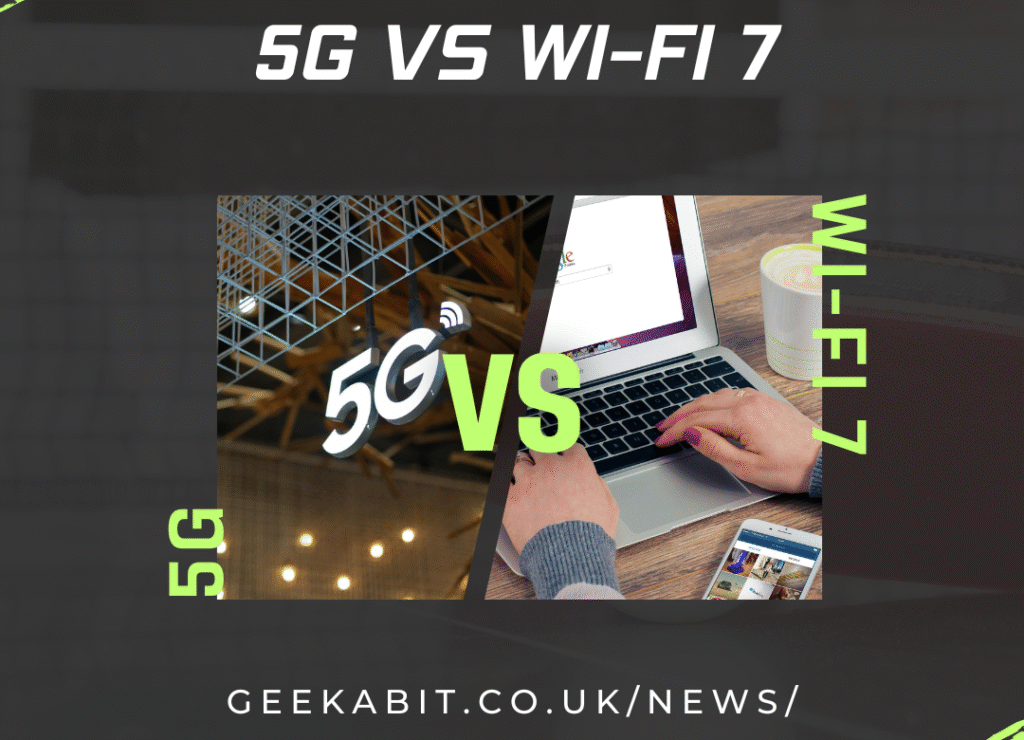Introduction: The Connectivity Dilemma of 2025
Over the past decade, digital connectivity has become the backbone of modern life. From streaming ultra-high-definition content to powering smart homes and supporting remote work, the demand for reliable and lightning-fast internet access has never been greater. Two technologies stand out at the center of this evolution: 5G and Wi-Fi 7. Both promise unmatched speed, ultra-low latency, and seamless device connectivity, but they serve different purposes and excel in different environments. Choosing between the two isn’t about deciding which is superior in a vacuum; it’s about evaluating your lifestyle, business needs, and future technology requirements. This article will break down their strengths, weaknesses, and real-world use cases to help you decide whether 5G or Wi-Fi 7 is what you truly need.
Understanding the Basics of 5G Technology
5G, the fifth generation of mobile network technology, builds upon the foundation laid by 4G LTE but expands it with incredible speed and reduced latency. It uses higher-frequency radio waves, known as millimeter waves, to deliver gigabit-per-second speeds. For consumers, this means faster downloads, smoother video calls, more responsive gaming, and improved performance for connected devices like smartwatches or IoT sensors. Businesses benefit as well, as 5G enables new innovations in telemedicine, autonomous vehicles, and large-scale industrial automation. The main advantage of 5G lies in its mobility: you can experience high-speed internet on the go, without being tied to a fixed location or wired infrastructure.
What Makes Wi-Fi 7 a Game-Changer?
On the other hand, Wi-Fi 7 (also known as IEEE 802.11be) represents the next generation of wireless internet technology designed for homes, offices, and public spaces. It promises speeds up to 46 Gbps, almost four times faster than Wi-Fi 6E, by using wider channels (up to 320 MHz), advanced modulation techniques like 4096-QAM, and multi-link operation (MLO), which allows devices to use multiple frequency bands simultaneously. Unlike 5G, which relies on cellular towers, Wi-Fi 7 depends on a local router connected to a broadband provider. This makes it ideal for environments where many devices are connected at once, such as smart homes, corporate offices, or entertainment venues. Its strength lies in capacity, stability, and affordability, as Wi-Fi generally costs less per month compared to unlimited 5G mobile plans.
Key Differences Between 5G and Wi-Fi 7
When comparing 5G vs Wi-Fi 7, it helps to understand their core differences. While both technologies can deliver fast, reliable connections, they operate under different infrastructures and use cases. To highlight these distinctions, here are three key takeaways:
- Coverage and Mobility: 5G offers broader coverage since it operates on cellular networks, making it accessible in cities, highways, and rural areas. Wi-Fi 7 is limited to where your router can reach.
- Cost Considerations: 5G often requires expensive data plans with limits on speed or usage, while Wi-Fi 7 leverages your existing broadband service at a fixed cost.
- Device Ecosystem: Wi-Fi 7 supports dense environments with dozens of devices connected simultaneously, whereas 5G excels in mobility and outdoor use.
This balance of mobility versus stability makes them less of competitors and more of complementary technologies.
Table 1: Technical Comparison of 5G vs Wi-Fi 7
| Feature | 5G Mobile Network | Wi-Fi 7 (802.11be) |
| Peak Speed | ~10 Gbps | Up to 46 Gbps |
| Latency | ~1 ms | ~1 ms or lower |
| Coverage Range | Wide (cell towers) | Local (router area) |
| Cost Model | Monthly data plan | Broadband + router |
| Device Density Support | High | Very High |
| Best Use Case | On-the-go, outdoors | Homes, offices, smart hubs |
Everyday Use Cases for 5G
The biggest advantage of 5G comes from its ability to provide consistent, high-speed connectivity regardless of your location. Imagine streaming a 4K movie while traveling on a train or hosting a live business conference call while driving through a major city. 5G ensures these experiences remain smooth. Gamers benefit from ultra-low latency, allowing mobile esports and cloud-based gaming to feel nearly instantaneous. For businesses, 5G supports field operations such as remote construction monitoring, drone deliveries, or even medical professionals guiding surgeries across continents.
- Stream content in 4K or 8K while mobile
- Use augmented reality apps in outdoor environments
- Enable IoT for smart city infrastructure
- Support autonomous vehicles with real-time communication
- Conduct business operations from remote locations
Such flexibility makes 5G a necessity for professionals and industries that thrive outside traditional indoor environments.
Everyday Use Cases for Wi-Fi 7
Unlike 5G, Wi-Fi 7 shines in stationary and high-density environments. Picture a modern household with smart TVs, tablets, phones, VR headsets, home automation systems, and gaming consoles all connected at once. Older Wi-Fi standards might struggle under this load, but Wi-Fi 7 can manage dozens of high-bandwidth devices simultaneously. Offices and enterprises gain enormous benefits too, especially in hybrid work environments where video conferencing, file transfers, and cloud applications all run concurrently without bottlenecks.
- Power multiple 8K video streams simultaneously
- Support virtual reality and AR for entertainment or training
- Deliver low-latency video conferencing for remote teams
- Handle smart home ecosystems with dozens of IoT devices
- Provide stable internet in crowded environments like stadiums
This reliability makes Wi-Fi 7 the foundation for next-generation homes and collaborative workplaces.
Table 2: Cost and Accessibility Comparison
| Factor | 5G | Wi-Fi 7 |
| Monthly Expense | $60–$120 (data plans) | $50–$80 (broadband + router investment) |
| Initial Setup | Minimal (SIM/device) | Requires Wi-Fi 7 router |
| Accessibility | Expanding but not universal | Limited to router range |
| Long-Term Value | Best for mobility | Best for capacity |
Which Technology Do You Really Need?
The question isn’t whether 5G is better than Wi-Fi 7 or vice versa—it’s which one fits your personal or business needs. If you travel frequently, rely on constant internet connectivity outdoors, or need real-time communications in the field, 5G is the clear winner. However, if your lifestyle or business is centered around a fixed location with many devices connected simultaneously, Wi-Fi 7 provides better speed, stability, and cost-effectiveness. For many households and enterprises, the real answer is not choosing one but adopting both. Hybrid solutions—such as routers that can use 5G as a backup when broadband fails—are becoming increasingly common.
The Future of Connectivity: 5G and Wi-Fi 7 Together
Experts predict that 5G and Wi-Fi 7 will not replace each other but will instead complement one another. 5G will dominate in outdoor, mobile, and industrial applications, while Wi-Fi 7 will rule in residential, enterprise, and entertainment environments. Future devices are already being built with dual compatibility, allowing seamless switching between networks depending on the situation. This trend ensures that consumers don’t need to stress over choosing one permanently but can instead leverage both for maximum flexibility.
Conclusion: Choosing the Right Path Forward
When comparing 5G vs Wi-Fi 7, the decision comes down to where and how you use your internet. 5G gives you freedom, mobility, and access beyond walls, while Wi-Fi 7 delivers unmatched stability, device density, and affordability at home or in the office. In reality, the future of connectivity lies in embracing both technologies as they continue to evolve. The smartest choice is to evaluate your current needs—whether you prioritize working on the go, gaming at home, or running a business—and adopt the solution that maximizes value in your everyday life.
FAQs: 5G vs Wi-Fi 7
1. Is Wi-Fi 7 faster than 5G?
Yes, Wi-Fi 7 offers higher peak speeds (up to 46 Gbps), while 5G typically caps around 10 Gbps.
2. Does 5G replace home Wi-Fi?
Not entirely. 5G is great for mobility, but Wi-Fi 7 provides better cost efficiency and device support for homes and offices.
3. What is the latency difference between 5G and Wi-Fi 7?
Both deliver around 1 ms latency, making them suitable for real-time applications like gaming and video calls.
4. Do I need a special device for Wi-Fi 7?
Yes, you need a Wi-Fi 7 compatible router and devices that support the new standard.
5. Is 5G more expensive than Wi-Fi 7?
Typically, yes. 5G requires monthly data plans, which can cost more than standard broadband connections.
6. Can Wi-Fi 7 work outdoors?
Not effectively. Wi-Fi 7 is limited to the range of your router, unlike 5G which covers wide outdoor areas.
7. Which is better for gaming, 5G or Wi-Fi 7?
Wi-Fi 7 is better for stationary gaming setups, while 5G works well for mobile or cloud gaming on the go.
8. Can 5G replace fiber internet?
In some cases, yes, but fiber still offers more reliable and consistent performance for heavy users.
9. Are there devices available today that support Wi-Fi 7?
Yes, flagship smartphones, laptops, and premium routers released in 2024 and 2025 already support Wi-Fi 7.
10. Should businesses invest in 5G or Wi-Fi 7?
It depends on operations. Offices benefit more from Wi-Fi 7, while field-heavy industries gain from 5G integration.


